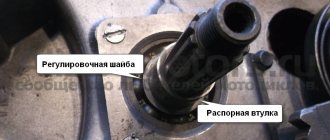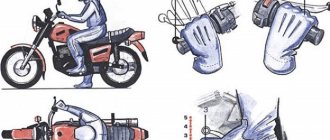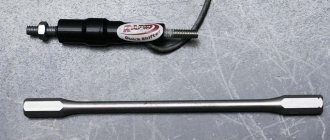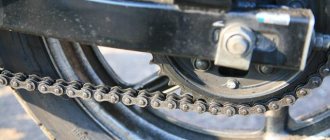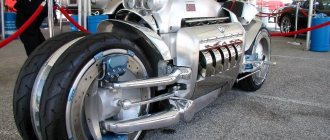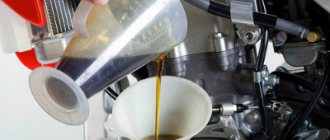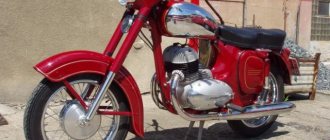Part 1. Gearbox.
Any device with a motor, be it a moped, scooter or motorcycle, needs a device to transfer the power produced by the engine to the wheel. This function is performed by a mechanism called “transmission” or “power train”. In our article today we will mainly talk about a motorcycle manual transmission.
Today there are two main types of transmission: manual and automatic. They differ in the level of intervention and control assigned to the rider. A manual transmission is used on the vast majority of modern production motorcycles; an automatic transmission is found mainly on mopeds and scooters, although there are also motorcycles with an automatic transmission (for example, Aprilia Mana 850 or Honda DN-01).
Aprilia Mana GT 2010 is one of the few motorcycles with an automatic transmission
There is a certain set of mechanisms that are present in any type of transmission: forward gear, clutch, gearbox and final drive. In a traditional manual transmission, the forward gear transfers power from the crankshaft through the clutch to the gearbox. The clutch is used to connect and disconnect the engine to the gearbox, allowing the engine to run while the bike is stationary and also to move away. The transmission allows a choice of different gear ratios to achieve maximum power and torque within the engine speed range. The final drive transfers power from the gearbox to the rear wheel.
Section of clutch discs Kawasaki Ninja ZX-10R 2008
In its simplest form, the operation of a small scooter's single-speed automatic transmission is not particularly difficult, while larger road machines use much more sophisticated mechanisms. It all depends on the purpose of a particular device and the characteristics expected from it. A fifty-kopeck car is required to simply move the rider over short distances, be cheap to purchase and easy to repair—such a car does not need a six-speed manual transmission. And it is needed where a large range of movement speeds, distances covered and various loads are required.
Gear transmission, torque and power
Let's understand the key concepts in “transmission issues”.
A gear train is two mating gears that rotate at different speeds. The gear ratio determines the difference in this speed. The process of obtaining a lower rotation speed of the driven (output) shaft in relation to the driving (input) shaft is called reducing (slowing down) the rotation speed. The reverse process is called increasing the rotation speed. These concepts apply not only to gear drives, but also to chain and belt drives.
Gear ratio is defined as the number of revolutions made by the drive gear in order for the driven gear to complete one full revolution. For example, if the engine speed is 1000 rpm, and you need to provide a wheel speed of 500 rpm, then you will need two gears, and the number of teeth of one of them should be twice the number of teeth of the other (this is just a simple example ; in fact, between the engine and the wheel there are many transmission mechanisms, more about which in the following articles). It is necessary that the smaller gear (for example, 15 teeth) be the drive gear, then while it makes one full revolution, the driven gear (30 teeth) will turn half a revolution. That is, in order for the driven gear to turn one revolution, the drive gear must make two revolutions. The gear ratio is recorded as 2:1. This means that such a transmission mechanism reduces the speed of the output transmission by half. These are the same numbers that the manufacturer indicates (albeit not as often as horsepower or torque) for each gear of its motorcycle. More often, a comparison of the number of gear teeth is provided, rather than the ratio of their rotational speeds. To avoid confusion, most often the following is indicated in the gearbox ratios characteristics column: first gear, 2:1 (15/30).
Now about the torque . Torque is the amount of rotation produced by a force applied about an axis (force, usually measured in newtons, multiplied by distance, in meters). In order for the bike to move, it is necessary to transfer enough torque to the rear wheel. To visualize what kind of animal this is, let's look at a simple example. When a wrench is used to tighten nuts, a torque is applied to the nut. Let's say the length of the wrench is 200 mm (0.2 m), and the hand force that is applied to it at a right angle is 100 N. Then the magnitude of the torque applied to the nut will be
100 x 0.2 = 20 Nm.
If we apply this to the operation of a gearbox, we can see that as a result of the action of a tooth on the drive gear on a tooth on the driven gear, the driven gear rotates. If the diameter of the gears is the same, that is, the number of teeth is the same, then they will also rotate at the same speed, and the amount of torque supplied to the shaft of the first gear will be completely transmitted to the shaft of the second gear.
Simply put, if the rotation speed of the driven gear is half the speed of the drive gear, then the torque also doubles. That is, there is a direct relationship between gear ratios and increased torque. Look at the characteristics of any motorcycle in our catalog, and everything will immediately become clear (for example, Kawasaki ER-6F 2008, section “Transmission”).
A feature of gasoline engines is that at low speeds they develop little torque. Therefore, the role of a torque amplifier is performed by the transmission. In the process of reducing the speed of rotation of the rear wheel (you need to provide sufficient torque to the wheel, but at the same time it should not rotate at a speed of 9000 rpm, like an engine!) All elements of the transmission are involved, with the exception of the clutch.
We sorted out the torque. Power is a physical quantity equal to the ratio of work performed in a certain period of time to this period of time. In physics, power is expressed in watts, but another quantity is very popular among motorcycle manufacturers - horsepower.
Interestingly, in many countries the “horse” has officially been phased out. That did not stop it from becoming a very popular measure of power in the auto and motorcycle industry.
In most European countries, horsepower is defined as 75 kgf m/s, that is, as the power sufficient to lift a load weighing 75 kg to a height of 1 meter in 1 second. In this case, 1 hp. is approximately 735.5 watts.
What does all of the above mean in relation to motorcycles?
For the rider, torque is the most important factor. The bike will accelerate at a rate consistent with its torque curve (ignoring friction and air resistance in this case). Peak torque is the point at which the bike accelerates most quickly (either side of this point the acceleration is slower). For a given rear wheel torque value, acceleration will be the same regardless of engine speed. The peak of maximum power occurs after the peak of torque - when the decrease in torque is compensated by an increase in speed. The acceleration intensity at peak torque is greater than at peak power.
The water mill wheel produces enormous torque. Just not enough revs.
Then why do we talk so much about power? Imagine a large water mill wheel. Obviously, this wheel generates enormous torque, but its rotation speed is very low. Accordingly, its power (that is, the ability to do a lot of work in a short time) is very low. In general, a water wheel is a low-power “engine” precisely because of its low rotation speed. In the case of motorcycles, a powerful engine with a lot of horsepower is one that generates a lot of torque at high speeds.
In theory, producing a lot of torque at high rpm is better than doing the same thing at low rpm. Because in the case of high speeds, there are more possibilities for adjusting gear ratios. A powerful engine is useful because you can choose between many different gear ratios. Selecting a low gear ratio reduces rear wheel speed with a corresponding increase in torque. (Haven't you fallen asleep yet? It will be easier later! Editor's note)
To the average rider - to the average star!
The stock set of gears in the box and the associated gear ratios were chosen by the manufacturer for a reason. These are compromise ratios that were most suitable for test pilots under “average” test conditions. As soon as the bike is in the hands of the buyer, the harmonious picture collapses. Engine tuning, operating conditions that are far from the ideas of naive engineers (for example, stunt riding), differences in the configuration of various tracks (if the rider likes to ride not only in civilian conditions). All these factors will sooner or later lead the rider to think about replacing a couple of gears in the transmission - in order to adapt the motorcycle precisely to the conditions in which it is most often used. And if it’s as easy as shelling pears to replace the driven sprocket attached to the wheel on any motorcycle (as a rule, stuntriders are limited to this only in matters of gear ratios), then changing the ratio on one of the gears in the box will already require disassembling the engine (unless the gearbox is cassette type, but more on that below).
As we have repeatedly noted, almost every decision made when designing a motorcycle is a compromise. In the case of choosing a gear ratio, there is a compromise between acceleration and maximum speed. To make a “sprinter” out of a bike (that is, to get intense acceleration at the expense of maximum speed), you need to install a smaller drive sprocket, or a larger sprocket on the wheel. If you want the opposite effect, do the opposite, everything is quite simple.
Now let's take a quick look at the working principle of a manual transmission, which is used on most production motorcycles.
Operating principle of the gearbox
The gearbox consists of many pairs of gears. Each pair has its own gear ratio, and the number of such pairs corresponds to the number of gears that are “hidden in the box” of the bike. One gear is located on the drive shaft (also called the primary shaft), the other is on the driven shaft (also called the secondary). All modern motorcycle gearboxes are constant mesh, that is, all pairs are in constant mesh, regardless of whether a given gear is engaged or not.
Suzuki GSX-R1000 K8 gearbox components
When the rider casually clicks the gear shift paw, a pair of mating gears are locked on their shafts, and torque is transmitted through this pair. The remaining gears are not interlocked with the shaft and rotate freely on it.
How does a sequential gearbox work?
Some gears are permanently fixed to the shaft and rotate with it, while others are mounted on bushings and can rotate freely on it. To ensure the drive, it is necessary to block such a free gear with the shaft; This means that you need to ensure its engagement with another gear located nearby and in constant engagement with the shaft. To do this, it is important that the gear meshed with the shaft moves towards the free gear and connects with it using cams and corresponding holes, while remaining in constant engagement with the gear from its pair.
The gears move on their shafts under the influence of the gear shift mechanism. When changing gears, the drum of the selector mechanism rotates and moves the gear shift fork, which is fixed at one end in the guide groove of the drum, and the other end enters the groove of the gear being moved, thus moving it.
Selector mechanism
It should be added that we described the design of a motorcycle gearbox, which has little in common with the “internals” of a manual gearbox on production cars. All mechanical boxes of modern production bikes are called sequential type gearboxes (in English “sequence” means “sequence”). The name fully corresponds to the functionality: switching can be done strictly sequentially, from first to second, from second to third gear and so on. The most important and obvious advantage of such a box is high switching speed. The difference in switching speed is so noticeable that such a box is often installed in sports cars prepared for racing. And we all know very well about the shortcomings. The main problem with motorcycle mechanics is changing gears when coming to a complete stop. This, again, is connected with the design itself - trying to “impossibly” kick into the desired gear in a static state, you can bend the forks in the box. After which you will definitely have to visit a mechanic who knows how to open engines, unless of course you have a motorcycle with...
Cassette type gearbox ! This thing is also sequential, but the difference from a traditional box is that the entire mechanism is not strictly fixed in the engine crankcase, but is placed in a cassette that can be easily removed without disassembling the engine (you just need to drain the oil and you can take it out).
Cassette gearbox Suzuki RGV250 1992
I don’t think it’s worth saying that the cassette box is ideal for sports motorcycles. Indeed, in field conditions it is not easy to “split” the engine in order to change a couple of sprockets in the box to better match the gear ratios to a specific track. We drain the oil, take out the cassette, change the gears, put it back in - and that’s it! The entire operation takes just minutes, and you can try out the new settings right away.
What about the clutch?
Sorry, but the article is already too long and quite difficult to understand. Although, I am sure that you, our dear readers, will fully understand my writing. Therefore, we’ll talk about the clutch, this integral part of a motorcycle transmission, next time. To justify myself in your eyes, I will also tell you what kind of beast a quickshifter is and how it works. See you in our cafe!
Part 2. Clutch and quickshifter
Any motorcycle must be able to disconnect the crankshaft drive from the rear wheel so that the engine can run when the bike is stationary. Despite this obvious statement, imagine this possibility did not always exist.
Many early motorcycles used direct drive via a belt and pulleys on the crankshaft and rear wheel that could not be separated. This drive really worked, but some problems arose during its operation. For example, to stop at an intersection, you had to turn off the engine. And in this case, it was possible to start the bike only from the pusher, which is clearly not the best starting option.
The clutch mechanism was designed to ensure that the running engine is decoupled from driving the rear wheel. The second function, no less important, is the ability to select gear ratios on machines that are equipped with a gearbox. Let's see how this mechanism works.
Clutch principle
Clutch operation is based on friction. In its simplest form, the clutch consists of two discs, one of which is located on the crankshaft journal, and the second is connected through some drive mechanism (chain, belt, gears) to the rear wheel and is pressed against the first disc. If there is a small gap between the disks, the engine runs while the second disk remains motionless. If you connect the disks to each other, the rotation of the crankshaft due to friction will be transmitted to the second disk, and since it is connected to the rear wheel, it will also rotate. So the power supply from the engine to the wheel can be switched on or off as needed.
The vast majority of modern production bikes use a manually operated clutch from a lever located on the handlebars. The exception is scooters that use an automatic centrifugal clutch, the operating mode of which depends on engine speed. Our article will focus specifically on the clutch that is used on motorcycles (unfortunately, the format of the article does not allow us to laugh enough at funny stories about scooter riders who switched to motorcycles and try to “brake” with the clutch).
How the clutch works
The entire clutch assembly is installed on the input shaft of the gearbox (read about the design of this device in our article). housing or outer drum is mounted on a bearing and can rotate freely and independently of the shaft. The outer clutch drum is directly connected through the forward gear to the crankshaft (although there are also designs in which the clutch is mounted directly on the crankshaft journal; this arrangement is common on motorcycles made by BMW and Moto Guzzi), so that when the crankshaft rotates, it also rotates. The central part of the clutch, or inner drum (hub), is smaller and is located inside the outer drum. It is installed on the input shaft of the gearbox and is secured against rotation by splines, so that when the inner drum rotates, the input shaft also rotates.
Section of a multi-plate clutch in an oil bath, Yamaha R6 2008
The clutch discs are located in the space between the outer and inner drums. Two types of discs are used: smooth and friction. They are arranged alternately, and the exact number of discs depends on the type of clutch and the machine on which it is used. On the outer circumference of the friction discs there are rectangular splines that are installed in the grooves of the outer clutch drum. On the inner circumference of the smooth discs, teeth are cut, which are installed in the grooves of the inner clutch drum.
In the normal position (when the bike is in motion), the friction and smooth plates are held in direct contact by springs acting on a plate called the pressure plate . When the crankshaft and outer clutch drum rotate, due to the friction that occurs between the plates, the inner clutch drum, and therefore the transmission input shaft, also rotates.
When the rider squeezes the clutch lever, the cable or hydraulic mechanism, counteracting the force of the springs, pushes the pressure plate away from the pack of smooth and friction plates, causing the discs to no longer touch. By eliminating direct contact between the discs, friction is reduced, allowing the outer drum to rotate freely relative to the inner drum. As the rider releases the clutch lever, the discs are pressed against each other again, and gradually the rotation of the outer clutch drum due to friction begins to be transferred to the inner drum, thus gradually transmitting torque to the gearbox and further to the rear wheel; this eliminates the possibility of stopping or jerking (of course, if you do everything correctly and release the clutch smoothly).
The ability of the clutch to transmit torque depends on many factors: the number and diameter of the discs, the force of the springs compressing them, and the coefficient of friction between the discs. All other things being equal, smaller machines require fewer disks than large, powerful machines. Likewise, if the torque is the same, then by increasing the diameter of the disks their number can be reduced. Friction discs (who would have thought?) have friction material applied to them, while smooth discs are made of steel.
2007 Honda CBR1000RR Clutch Components
Design matters
When choosing the type of clutch to be installed on a particular motorcycle, several determining factors influence the designer's decision. First, let's look at the number of disks.
A multi-plate clutch uses more than one set of smooth and friction discs, usually seven or eight, and sometimes nine friction discs are used. There are always one fewer smooth discs compared to friction discs, since the disc package is always limited on both sides by friction discs.
On most monoblock engines (that is, those in which all transmission components are located within the engine crankcase) with a transverse crankshaft in the frame, a multi-plate clutch is used. The reason for this is the small clutch diameter. A multi-disc clutch is also much lighter than a single-disc clutch, although it has a larger friction surface and strength.
Single- or double-plate clutches are used on motorcycles with a longitudinal crankshaft in the frame (for example, Moto Guzzi bikes with a V-twin, the cylinders of which are located across the frame). The clutch is mounted on the rear journal of the crankshaft and has a separate housing between the engine and gearbox. Because of this arrangement, the clutch does not need to be compact, and with large diameters only one or two discs are needed.
The next question that designers decide is to use a dry clutch or one operating in an oil bath.
Ducati 749 dry clutch on display (covered in stock, of course)
It may seem strange that a mechanism whose principle is based on friction should operate in oil; but there are several important reasons for this. The oil acts as a heat dissipator to prevent the clutch from burning. In addition, it serves as a lubricant for the bushings or bearings on which the outer clutch drum rotates, and also facilitates the movement of splines and disc teeth. An additional “bonus” of an oil bath clutch is that to ensure lubrication of the front gear, you do not need to seal the clutch in a separate chamber.
You can’t go against physics - naturally, the friction provided between the clutch discs operating in an oil bath is lower than the friction between the dry clutch discs. Therefore, large-diameter disks or a larger number of them are required (or perhaps both), which leads to increased dimensions.
Suzuki RGV250 equipped with dry clutch
The same RGV250, but with an oil bath clutch
This is why dry clutches are mainly used on sports bikes. High efficiency and low weight (no need to pour oil) are an integral part of a dry clutch. However, the same as a small resource. Most racing machines are equipped with a dry clutch, as are almost all civilian Ducati sportbikes (except for the 848, but there is a separate one for it). Japanese manufacturers mainly use oil bath clutches. From a practical point of view, a “wet” clutch looks preferable - a much longer service life and less tendency to overheat. On the other hand, if the goal is maximum performance in a race, then the choice will be in favor of a dry clutch.
Nothing is broken here, this chirping sound is the sound of a working dry Ducati clutch
Another point that the designer must decide is how the force from the lever will be transmitted to the clutch drive mechanism. Most often, a cable is chosen for this purpose, otherwise a mechanical clutch drive . Cables are subject to stretching and wear, and require adjustment and lubrication, but are easy to maintain and repair. The mechanical drive is simple - the cable acts on the clutch through a drive mechanism located inside the clutch cover or on the opposite side of the crankcase, while the mechanism acts on a long pusher passing through the input shaft of the gearbox.
The hydraulic clutch drive mechanism is used mainly on large-volume machines. It costs much more and requires careful maintenance, but the shortcomings are more than offset by the smoothness and ease of its operation.
The hydraulic drive operates on the same principle as the front brake system (we will also talk about brake systems in due course): when the lever presses on the master cylinder plunger, it acts on the hydraulic fluid and forces it into the hose. The fluid then pushes the piston of the working cylinder, which acts on a pushrod located inside the input shaft.
Other than regularly checking the fluid level, the hydraulic system requires little to no maintenance, although fluid and seals must be replaced periodically to keep it functioning properly. Also, the design of any hydraulic system implies that the fluid is prone to absorbing water and becoming saturated with air (in short, servicing the hydraulic clutch is similar in care to servicing the brake system). With that out of the way, let's move on to more modern and high-tech stuff.
I think that while reading reviews of modern motorcycles, you have repeatedly come across the phrase “slipper clutch.” As a rule, the presence of it on the motorcycle being tested delights the tester, which he immediately reports. However, no one really explains how this thing works. Let's start with this.
Slipper clutch
- The slipper clutch is specially designed for circuit racing to “soften” the engine braking process in corners. The clutch literally slips when the motorcycle's rear wheel forces the engine to rev faster after downshifting. In such cases, the excess load on the transmission is relieved and riding the bike becomes more predictable and comfortable, because in similar situations with a conventional clutch, the rear wheel noticeably “sausages” and the engine roars excessively. Moreover, the slipper clutch helps inexperienced riders avoid trouble when suddenly opening the throttle. The sliding clutch first appeared on the Honda FWS1000 sports motorcycle in 1982, and by now almost all liter sportsbikes are equipped with it.
Slippery type
The clutch slipper mechanism (hereinafter referred to as “SC” for simplicity) is a development aimed at high-performance motorcycles. The main goal for the PS is to limit the reverse torque that appears when braking the engine from high speed or when changing to lower gears.
For the first time, the PS was used on a drag bike of the 70s under the name Hogslayer - a non-trivial clutch for that time allowed the “Pig Killer” to accelerate to 290 km/h without slipping or overheating (in addition, two 880 cc injection engines contributed to this maximum speed from Norton, but that's a completely different story...).
Among modern production motorcycles, the slipper clutch has also found its place - mainly, it is equipped with sportbikes, as well as charged factory street bikes.
Slipper clutch for Ducati 999 from FBF
Now let’s take a closer look at why PS is used in general. When the gas is opened, the rear wheel is driven through the clutch. When the throttle is closed and the bike continues to move at a speed higher than the set limit corresponding to the current throttle opening, the rear wheel is still turning the engine shaft through the clutch; but because the engine offers a lot of drag (due to compression, especially at high speeds and lower gears), it is possible to reach a point where the drag, or back-torque, of the engine exceeds the rear tire's coefficient of adhesion. The result of this is a locked rear wheel. This outcome is especially likely in rainy conditions, because... in the rain, the coefficient of adhesion between the tire and the road is greatly reduced, and the weight redistribution that occurs during sudden braking reduces the load on the rear axle. PS is installed in order to eliminate the possibility of wheel locking due to clutch slipping when changing the direction of torque transmission. However, the PS does not disengage the clutch completely, and the engine braking effect remains.
Different manufacturers approach the design of the clutch in different ways, but most often slippage is ensured by the following mechanism: the inner clutch drum is located on a series of ratchet stops with an inclined surface. When the direction of torque transmission changes, the inner clutch drum moves on the ratchet stops, thereby retracting the pressure plate and relieving pressure on the discs. This approach was commercially tested for the first time on the Kawasaki ZXR 750.
2007 Kawasaki ZX-6R Slipper Clutch - Standard
Aprilia engineers took a more complex and technological path when designing the RSV Mille clutch. To move the inner clutch drum, a servomotor is used, which is controlled by a vacuum supplied from the engine intake manifold. When the throttle is closed, the increased vacuum in the manifold creates a vacuum in the air line of the servomotor, which shifts the inner clutch drum and relieves pressure on the discs. This approach is no longer used anywhere except RSV; manufacturers prefer a simpler option, tested on the ZXR 750 (each company tries to bring something different to the PS design, but the general principle remains very similar to the Kawasaki version). Whatever one may say, despite its simplicity, the slipping mechanism in the clutch is a very, very useful thing. If your motorcycle is not equipped with PS, do not despair, it is likely that a tuning kit for it exists in nature, you just need to look for it.
Quickshifter
Finally, we got to the long-awaited topic - Translogic quickshifter systems, also known as BMW Quickshifter. Contrary to the sensational statements of the German company about the new super technology, such systems of “quick gear shifting without the rider releasing the clutch”, produced by some tuning companies, the most famous of which are Translogic and Dynojet, have long been used by participants in the World Superbike, Supermoto/MX and even go-karts It's just that BMW was the first company to decide to install this system in some production bikes.
The advantage of the mechanism is inherent in its very name: “quick” - “fast”, “shift” - “shift, displacement, switching”. That is, “quickshifter” literally translates as “quick switch”. How quickly do the gears change, you ask? The answer can be found in the example given on the official Translogic page. “The most professional motorcycle racer takes at least 340 milliseconds to change gear, while Translogic systems require 48 to 150 milliseconds.” Impressive, isn't it? Another technology that came down from the Olympus of big-time motorsport and became accessible to “mere mortal” motorcyclists.
- Kit - (from English Kit) a kit for tuning individual components of a motorcycle.
DynoJet QuickShifter Kit
Now let’s look at the “quick click” device. The key elements of the entire mechanism: a pressure sensor (monitors the pressure on the gear shift foot; simply put, it determines whether the rider presses it or not) and a quickshifter rod (if the standard one does not fit). Some manufacturers (for example, Dynojet) also offer a quickshifter on/off button that can be mounted on the steering wheel. The sensor is connected to an external ignition control module (for example, Power Commander). When the rider puts pressure on the gear shift paw, the sensor sends a signal to the ignition control module, after which it instructs the ECU to temporarily turn off the ignition (for a few tens of milliseconds). When the engine is turned off, switching occurs - without releasing the gas or squeezing the clutch. In the case of BMW motorcycles, there is no need to buy an ignition control unit - the quickshifter is connected to the original “brains”, nothing needs to be adjusted or installed. Usually a quickshifter is installed when they want to improve the acceleration dynamics of the device, but nothing prevents you from shifting down in the same way when braking.
“Stars, forks, gears...” is published with the permission of the editors of the online magazine Source: Motocafe.ru. Author Artem Terekhov.
How to change gears on a motorcycle
Most motorcycles are equipped with a sequential gearbox. Therefore, the basic principles of all actions are similar.
Gear shifting on a motorcycle differs between “up” and “down”.
The first one means you need to shift into a higher gear. To do this, you engage first gear, and thus increase the speed of the motorcycle, and then gradually shift to the next gear in the following sequence:
Any shift to a higher gear occurs in this sequence.
To engage a low gear, use the downshift. This is done when it is necessary to increase the power of the rear wheel, for example, when going uphill. What is the sequence of actions in this case?
If you want to slow down or stop the motorcycle, you must release the gas before you press the clutch. Brake until you shift from first to second gear.
Sequence of actions when starting off:
Torque limiter
For beginners, switching down is quite difficult and not entirely clear. The likelihood that the rear wheel will suddenly lock is high. Therefore, motorcycle manufacturers have been installing a so-called torque limiter in the clutches of most motorcycles for about 10 years. The torque limiter should not be confused with the slipper clutch used on racing motorcycles. The main difference is that the limiter is activated when the clutch is not fully depressed, namely at the moment when you release the clutch. So if you accelerate in second gear, squeeze the clutch, lower the engine speed and now release the clutch, then the torque limiter will work a fraction of a second before the lever drops. The limiter is designed to combat the “jumping” of the rear wheel if you make a mistake with the speed at which you shift down or up. Remember - the limiter does not work with the clutch fully released and is not a panacea against locking the rear wheel.
When to switch
There are features of how and when to change gears at different gearboxes (“manual” or “automatic”). In any case, you should first study the basic basics, such as the location of the clutch handle, the rules for setting and releasing speed, and the gear shift lever. They are used subsequently to perform these actions.
The clutch lever is depressed and at one moment the gear shift lever is pressed with the left foot. After engaging first gear, gas is gradually added by turning the handle, and the clutch is slowly released.
Using the toe of your left foot, the lever is raised up to a characteristic click at 2nd and subsequent speeds. Some “aces” make the switch in a simpler way: they slightly lift the lever with their toes and release the gas. But this requires some experience for smoothness. Otherwise, the service life of the clutch will be significantly reduced due to increased wear.
It may be necessary to downshift. After releasing the gas by approximately 2,000 - 3,000 rpm by braking, depress the clutch and shift the speed down. This can be continued until neutral is turned on. Smooth operation will only occur when the actual speed is lower by approximately 500 - 1,000 revolutions of the lower gear.
Otherwise, a jerk will be felt.
If we take into account the automatic transmission, there is no need to engage the clutch here, since it is interconnected with the gearbox. For this reason, switching can be performed at any speed while driving. When the gas is released, the gear shift lever is pressed down. There should only be one click for the first transfer. Higher speeds are activated in the same way, but only the lever rises when the gas handle is released (one click). To reset the gears, press the lever downwards. In this case, it is better to do it this way: apply the gas and immediately remove your hand from the handle, and after the speed drops, switch the speed and add gas again in the required amount.
All motorcycle speeds and its maximum speed
The maximum speed of a motorcycle depends on the power of the bike and the drive gear ratios.
Motorcycles of different sizes can reach speeds from one hundred and forty kilometers to three hundred and forty kilometers per hour. You don't need to make your bike's top speed an end in itself. Much more important is how dynamic your motorcycle is at all possible speeds. Gear ratios can be increased or decreased to improve the motorcycle's performance. For example, for city streets the maximum speed is not higher than 220 km/h. In this case, the gear ratios are selected so that at this speed the sixth gear is turned into the cutoff. The motorcycle will gain such important dynamics for it.
For track racing, the gear ratios are chosen slightly differently so that all six gears are used until a top speed of 280 kilometers per hour is achieved.
Replacing gear ratios is considered the cheapest tuning and does not affect the wear of the motorcycle.
Source
Adviсe
All actions performed when changing speed must be carried out quickly but smoothly. Relieving the gas and squeezing the clutch must be done simultaneously. If the pause is long, the motorcycle will stall.
If, on the contrary, squeezing the clutch precedes releasing the gas, the bike will roar and begin to twitch when the speed is subsequently changed.
You need to change gears while moving in a straight line. Before entering a turn, you should understand the speed.
Once you have mastered the basic shifting of gears on a motorcycle, you will see that in some cases the clutch may not be used. For example, at significant engine speeds, it is enough to simply press the gearshift pedal up.
How to change gears on a motorcycle correctly
All movements you make with the pedals must be smooth so as not to damage the transmission.
When changing gears, change one speed at a time. It is not advisable to jump.
To understand how to change gears on a motorcycle, you need to carefully study the controls. There are motorcycles with manual transmission and semi-automatic.
Gear shifting methods
Method one
Motorcycles with manual transmission. All actions in this case occur in the following sequence. Pick up speed. Take off the gas. Engage the clutch. Press the gear shift pedal. Release the clutch, then the shift pedal and add gas.
To start the motorcycle, place it in neutral. After this, remove the gas and squeeze the clutch, at the same time turning on first gear. Taking your foot off the gear pedal, apply gas and release the clutch. Now add gas.
To upshift, you need to lift the gas, engage the clutch and press the gearshift pedal. After this, release the clutch, release the shift pedal and add gas.
To downshift, you need to remove the gas and engage the clutch. After this, sharply add gas, and when the speed begins to drop, press the gearshift pedal. Release the clutch and shift pedal and add gas. Once the motorcycle has stopped, be sure to put it in neutral.
Method two
Motorcycles with semi-automatic transmission. On these motorcycles, gear shifting is easier. Take off the gas and change gears. The clutch and gearbox are connected here.
Before starting the engine, place your bike in neutral. In order to engage first gear, you need to remove the gas and press the gear lever down. To increase the gear, you need to remove the gas and lift the gear lever up. To downshift, on the contrary, you need to apply gas and immediately remove your hand from the gas. When the speed starts to drop, change the speed and add gas. Now you know how to change gears on a motorcycle.
How to change gears on a motorcycle?
Having the skills to ride a motorcycle, as well as high-quality motorcycle equipment, is the key to confident and safe riding. Therefore, today we will look at the basic skills of competently switching gears on a motorcycle. The process of changing gears occurs in a sequential mode: when increasing speed - from bottom to top, when decreasing - from top to bottom. This feature makes novice bikers nervous, as it causes certain difficulties. The hardest thing is for those drivers who permanently transfer from a car to a motorcycle or vice versa. Riding a motorcycle, like any other field, requires experience. Of course, it comes with time, and gear shifting is already carried out on an intuitive level, the scheme is simply fixed in the “subcortex”. Beginners make a lot of mistakes when learning to ride a “two-wheeled iron horse.” One of the first features that they sometimes do not take into account is that switching cannot be done until the engine reaches sixty to seventy-five percent of the maximum possible number of revolutions.
Otherwise, all this can lead to:
To change speed while moving, you need to release the accelerator handle while simultaneously squeezing the clutch. Then move the shift lever up or down and calmly release the clutch, while slowly adding gas.
Factors influencing speed changes
The efficiency of gear shifting depends on a number of factors, including the convenience of the clutch lever location. You need to press on it with all your free fingers, so it is not recommended to use short handles. Typically, there are a number of difficulties in effectively changing gears. Among them, for example, is the slope of the lever and its large lift. Because of this location, beginners can barely reach it.
On your marks!
The overwhelming majority of new bikers experience some difficulties with a smooth start from a standstill. In order to avoid problems, you need to memorize the following sequence of “starting”:
As a rule, the separation from the starting point occurs around three thousand revolutions. The success of a competent start lies in a smooth increase in engine speed with a smooth release of the clutch.
Moving the gear lever
Gear shifts must be carried out sharply enough so that the engine speed does not increase too sharply. An increase of one and a half thousand revolutions is considered optimal. If the switching is slow, then the accelerator handle must be closed. Increasing gears should be done at higher speeds; at lower speeds you will have to “over-throttle”. Some motorcycle models have the ability to change speeds without pressing the clutch. Moreover, this can be done at any speed. This method involves lowering the “aspiration” for a small interval using the accelerator handle. In parallel, the transmission increases. Of course, in order to accurately perform such manipulations, experience is required, but it is gained quite quickly with persistent efforts to learn how to change gears correctly.
Common mistakes
Almost all novice motorcyclists sit incorrectly behind the wheel of their “iron horse”: with their arms fully straightened or slightly leaned back. The fact is that when the clutch is abruptly released and the accelerator lever is simultaneously pressed, a sharp jerk may occur, as a result of which the driver simply falls from the vehicle. You need to release the gas before the clutch is depressed. The engine makes growling sounds, increasing the roar. Some people get scared by this, thinking that some kind of breakdown is happening and completely abandon the accelerator. As a result, the bike “stalls” due to the fact that the engine “locks” the drive mechanisms.
Delayed clutch release
When the speed drops, there is no need to be slow in squeezing the clutch. The speed can drop in a matter of moments, and so sharply that you have to start accelerating again to get to the desired gear.
Breaking stereotypes
There are countless different “beliefs” circulating around the process of changing gear on a motorcycle, which have no practical basis. Thus, there is an opinion that the speed of changing gears affects the wear of the clutch. Also, some people believe that it is allowed to slow down using a “box”, that it is necessary to change speeds only at higher speeds, and so on. In fact, you just need to learn the entire process of starting and then changing speeds once and for all. This will protect the driver from losing control of the vehicle and avoid an emergency situation. Of course, the basics of management must be learned away from highways and large concentrations of people and cars. It is strictly forbidden to ride a motorcycle without a helmet. After all, as statistics show, almost no new biker goes without falling while learning to ride a “two-wheeled iron horse.”
Switch down
In order to understand what you should be wary of when shifting down, do a simple exercise: accelerate in second gear and completely close the throttle, while braking the engine, depress the clutch and roll with the clutch depressed, you will see that the engine speed will drop to idle, now, if you release the clutch there will be a sharp push, up to the temporary blocking of the rear wheel - the motorcycle will try to spin the engine from idle speed to the speed at which the motorcycle is currently moving. If you raise the speed when you release the clutch, the push will be less noticeable, and if the engine speed matches the speed at which the motorcycle is moving in second gear, there will be no jerk at all.
Content
Why is a gearbox necessary? [edit | edit code]
The principle of operation of a gear drive is quite simple. It can be used to change the shaft rotation speed to the currently required value. For example, if the shaft rotates at a frequency of 2000 rpm, and it needs to be reduced by half, then it is necessary to install a drive gear on the shaft and connect it to a driven gear located on another adjacent shaft. If the number of teeth of the drive gear corresponds to half the teeth of the driven gear, then every two revolutions of the drive gear will correspond to one revolution of the driven gear, and the shaft to which it is attached will rotate at a speed half the speed of the drive shaft.
If you apply this to a motorcycle drivetrain, there is another factor to consider. The required driving speed is determined not only by changing the engine speed through a gear drive, it is also determined by the number of power strokes occurring for each revolution of the rear wheel. Thus, in the lowest (1st) gear, the number of power strokes for each revolution of the rear wheel will be greater, and therefore the power will be higher than in higher gears. This is necessary so that the car can overcome the inertia when starting to move, which can be checked if you try to start moving in a high gear.
As we can see, the need to use a gearbox is caused by the characteristics of the internal combustion engine. Let's take an imaginary engine: useful power can be produced in a relatively narrow frequency range from 2000 to 8000 rpm. First of all, it is necessary to reduce this number of revolutions to such speeds that would provide the rear wheel with a normal speed. The required number of revolutions depends on the outer diameter of the wheel, the direct elements of the gearbox and engine power.
For example, if we consider a single speed scooter, we will find that the total gear ratio will be around 15.00:1. This means that every 15 engine revolutions will correspond to one revolution of the rear wheel. This ratio must be selected after the wheel diameter has been determined, taking into account the best use of useful power. If the gear ratio is too high, it will be impossible for the car to move. However, if it is too low, the car will begin to accelerate quickly. but its maximum speed will be limited by the maximum engine speed. On larger displacement and more powerful engines, higher gearbox ratios can be used to achieve higher top speeds, but starting is still a problem. Even though the engine's power increases, its range is limited, forcing the addition of idler gears to increase the overall gear ratio. There must be a certain interval between the gears so that, having reached high speeds in one gear, after engaging the next gear, the engine speed drops to the lower limit of the power range.
It is necessary to be able to select constant gear ratios that stepwise change the degree of reduction in rotation speed. Most cars use four, five or six gears. This number of gears provides a compromise between the ideal ratio spacing and the need for frequent gear changes. Imagine how tedious it would be to change ten gears! What is important is the actual time spent on each shift, during which the car does not accelerate. Probably, such a car would lose to a car with fewer gears in the overall acceleration dynamics. The number of gears is also related to the purpose of the motorcycle. For example, on sports two-stroke engines with a very narrow power band (around 2000 rpm), beyond which there is no useful power, the engine must be operated within this range to make use of useful power. so that the number of transmissions is greater.
